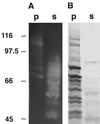In Thermoanaerobacterium thermosulfurigenes EM1 S-layer homology domains do not attach to peptidoglycan
- PMID: 10438774
- PMCID: PMC93991
- DOI: 10.1128/JB.181.16.5017-5023.1999
In Thermoanaerobacterium thermosulfurigenes EM1 S-layer homology domains do not attach to peptidoglycan
Abstract
Three exocellular enzymes of Thermoanaerobacterium thermosulfurigenes EM1 possess a C-terminal triplicated sequence related to a domain of bacterial cell surface proteins (S-layer proteins). At least one copy of this sequence, named the SLH (for S-layer homology) domain, is also present at the N terminus of the S-layer protein of this bacterium. The hypothesis that SLH domains serve to anchor proteins to the cell surface was investigated by using the SLH domain-containing xylanase. This enzyme was isolated from T. thermosulfurigenes EM1, and different forms with and without SLH domains were synthesized in Escherichia coli. The interaction of these proteins with isolated components of the cell envelope was determined to identify the attachment site in the cell wall. In addition, a polypeptide consisting of three SLH domains and the N terminus of the S-layer protein of T. thermosulfurigenes EM1 were included in these studies. The results indicate that SLH domains are necessary for the attachment of these proteins to peptidoglycan-containing sacculi. Extraction of the native sacculi with hydrofluoric acid led to the conclusion that not peptidoglycan but accessory cell wall polymers function as the adhesion component in the cell wall. Our results provide further evidence that attachment of proteins via their SLH domains represents an additional mode to display polypeptides on the cell surfaces of bacteria.
Figures







References
-
- Antranikian G. Physiology and enzymology of thermophilic anaerobic bacteria degrading starch. FEMS Microbiol Rev. 1990;75:201–218.
-
- Bergmeyer H U, Gawehn K, Grabe M. Enzyme als biochemische Reagenzien. In: Bergmeyer H U, editor. Methoden der enzymatischen Analyse. Weinheim, Germany: Verlag Chemie; 1974. pp. 454–558.
-
- Blum H, Beier H, Gross H J. Improved silver staining method of plant proteins, RNA and DNA in polyacrylamide gels. Electrophoresis. 1987;8:93–99.
Publication types
MeSH terms
Substances
LinkOut - more resources
Full Text Sources
Other Literature Sources

